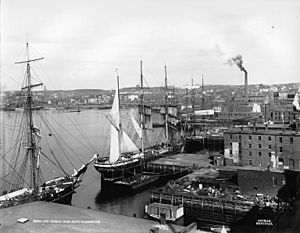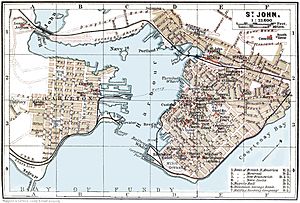Saint John Harbour facts for kids
Saint John Harbour is a big, natural harbour on the Atlantic coast of New Brunswick, Canada. It's located right in the city of Saint John, New Brunswick. A natural harbour is a safe place where ships can dock, protected from strong winds and waves.
Contents
Discovering Saint John Harbour
This important harbour includes several interesting areas:
- Anthonys Cove
- Hazen Creek
- Courtenay Bay
- Round Reef
- The mouth of the Saint John River
Islands in the Harbour
The harbour is also home to a couple of small islands:
- Partridge Island
- Navy Island

Getting Around the Harbour
To help people and vehicles cross the water, there are two large bridges over a narrow part of the harbour, often called "The Narrows":
- The Saint John Harbour Bridge
- The Reversing Falls Bridge, which opened in 1970
How the Port Works
The harbour is managed by the Port of Saint John. This organization makes sure ships can come and go safely, and that goods can be loaded and unloaded. It's a busy place that helps connect Saint John to the rest of the world through shipping!
Making the Harbour Cleaner
For many years, dirty water from the city used to flow directly into Saint John Harbour. This was a problem because it made the water unsafe and unhealthy.
The Big Cleanup Project
Thankfully, a huge project called the Saint John Harbour Cleanup began! It cost about $99 million and was finished in 2014. The goal was to stop all the untreated wastewater from going into the harbour.
Before the cleanup, about 16 million litres of untreated water went into the harbour every single day. This had been happening since the mid-1800s. In some places, this dirty water even flowed through streams right in the middle of the city.
What Changed?
The cleanup project built a third special plant to treat wastewater. This plant cleans the water before it goes into the harbour. They also built pumping stations to send the dirty water to this new treatment plant.
Cleaner Water for Everyone
After the cleanup, the amount of harmful bacteria in the water dropped by a lot – between 95% and 99%! This means the water became much safer. While some areas still need more improvement, the harbour is much cleaner now.
Before the cleanup, you could sometimes see things like toilet paper on the beaches. Also, a study found that fish in the harbour were affected by the dirty water, making them unsafe to handle. Now, thanks to the cleanup, the harbour is a much healthier and more enjoyable place for both people and wildlife.



